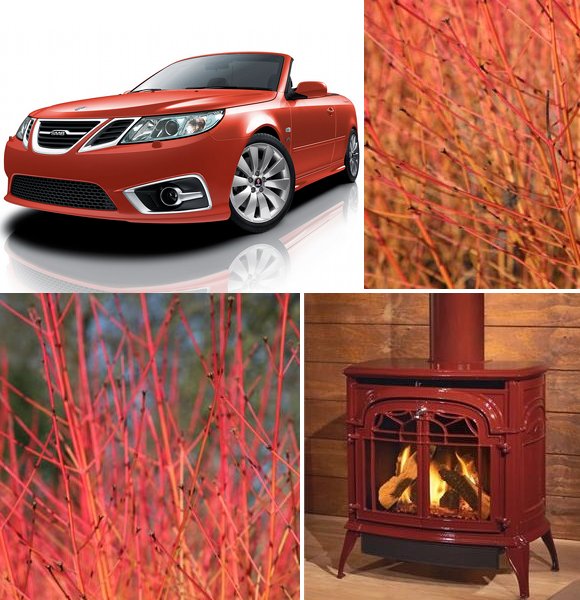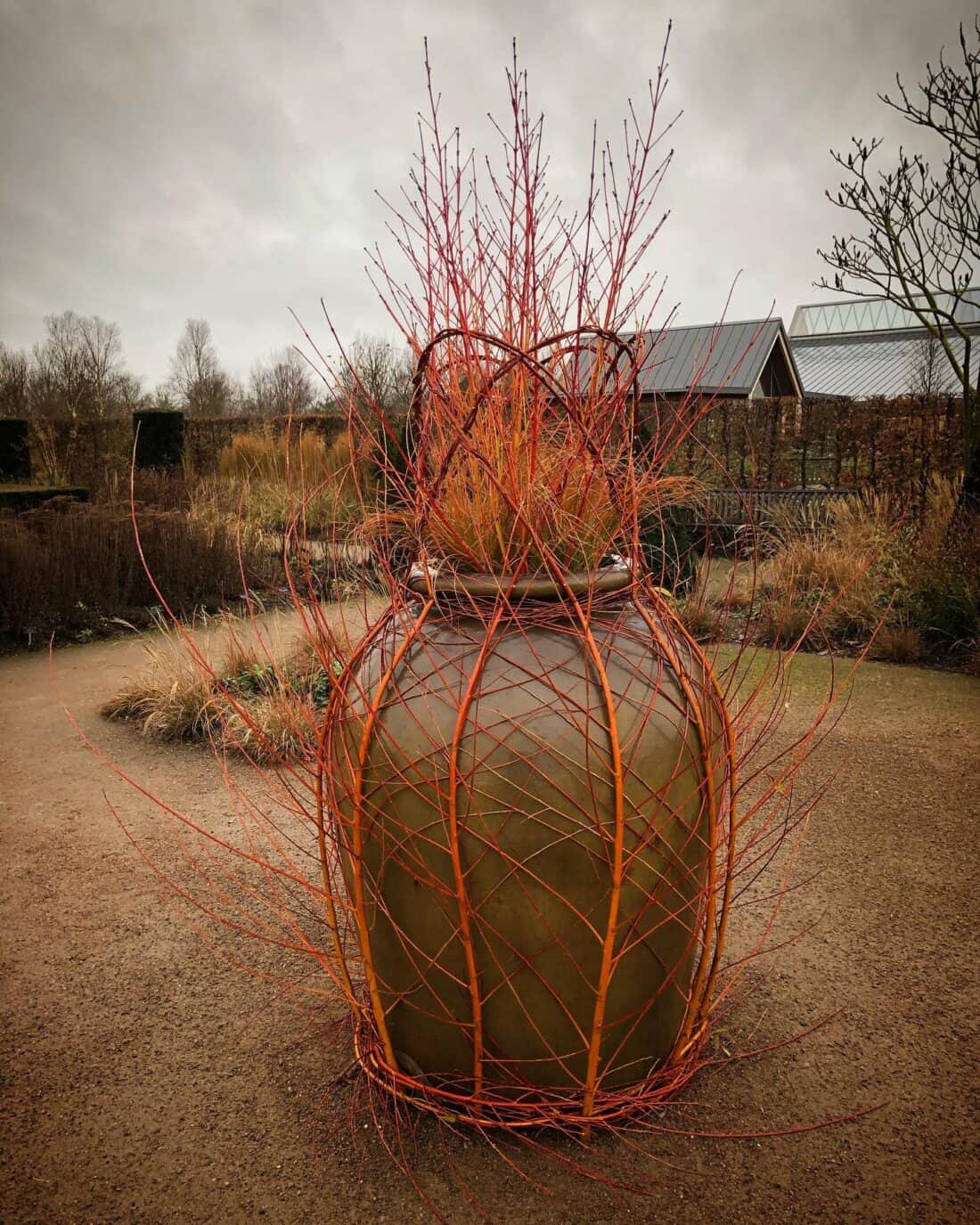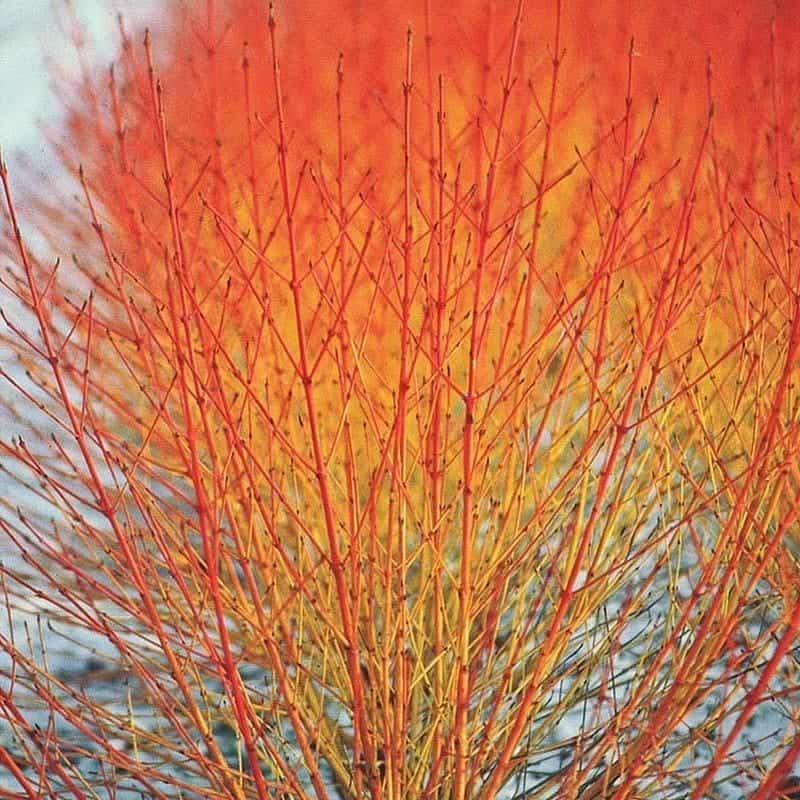When my wife and I first started dating 16 years ago, she let me in on a secret: her dream car was a fire-engine red Saab convertible. A bold choice, right? Fast forward through four kids, four cats, two dogs, and countless car seats, and that dream stayed alive—even while she drove minivans, SUVs, and an ancient 1987 Toyota pickup with 190,000 miles and a permanently broken seat (RIP, trusty steed).
This winter, I finally delivered on her dream… sort of.

Instead of a red convertible, I got her a candy-apple red wood stove. Okay, maybe it’s not quite the same, but let’s be honest—who needs a convertible in Maine winters? While she’s not exactly zipping down the coast with the top down, the wood stove is red, it opens (for logs), and it’s keeping the family toasty. Romantic, right?
Winter in Maine demands a little creativity to keep things colorful and warm, which brings me to the unsung hero of cold-weather landscapes: Cornus sanguinea ‘Winter Flame.’ This shrub is like having a wood stove for your garden—vivid, fiery, and capable of brightening even the dullest winter days.
Why Cornus ‘Winter Flame’ Is Worth the Hype
The first time I really noticed ‘Winter Flame,’ I was doing some trail work down by the river. Amid the muted winter palette of grays and browns, this mass of shrubs practically leapt out of the landscape with their yellow, orange, and red stems. It was like they’d borrowed the sunset and decided to wear it as a winter coat.
After some research, I learned that Cornus sanguinea ‘Winter Flame’ is relatively unassuming for most of the year. In spring, it produces small white flowers typical of shrubby dogwoods—nice but not exactly showstopping. By fall, the leaves turn buttery yellow before dropping to reveal the real show: stems that start yellow at the base, shift to orange, and blaze into red at the tips.
These colors are their most vivid in winter when the rest of the garden is quiet. If you’re looking for a shrub that performs when everything else is asleep, ‘Winter Flame’ delivers.
How to Grow and Care for ‘Winter Flame’
Here’s the best part: Cornus sanguinea ‘Winter Flame’ is as low-maintenance as it is eye-catching.
- Hardiness: Thrives in USDA zones 5–7b, so it handles cold with ease.
- Light: Happy in part shade to full sun.
- Soil: Moisture is key—this shrub loves damp conditions, though it’s adaptable to a range of soils.
One important care tip: prune regularly. To keep the fiery stem color vivid, cut back the older stems every 2–3 years in early spring. Older wood tends to turn brown and lose its vibrancy, but the younger stems are where the magic happens. Pruning also keeps the shrub from getting out of hand—it can grow up to 10 feet tall and wide if left unchecked.

Image and design by brendanarundel along with @9349sam at RHS Garden Hyde Hall.
Design Ideas: Where ‘Winter Flame’ Shines
Looking for ways to incorporate ‘Winter Flame’ into your landscape?
- Winter Borders: Plant in clusters or mix with evergreens for a stunning winter contrast.
- Rain Gardens: This shrub thrives in wetter spots, making it a perfect addition to a rain garden.
- Wildlife Gardens: In fall, the small black berries provide food for birds and other wildlife.
‘Winter Flame’ isn’t just a pretty face—it’s part of a larger movement to make winter gardens more than an afterthought. By choosing plants like this, we can create landscapes that shine year-round and contribute to ecological health. This cultivar, bred by the renowned Andre van Nijnatten, is a reminder that even in the darkest months, beauty and life persist.
So if you’re craving a little extra warmth this winter—whether it’s a wood stove, a red convertible, or something for your garden—give ‘Winter Flame’ dogwood a try. It might just be the spark your landscape needs.
Do You Grow Cornus sanguinea ‘Winter Flame’?
I’d love to hear how you’re using Cornus sanguinea ‘Winter Flame’ or other shrubby dogwoods in your garden. Do they brighten up your winter days? Drop me a note or share your favorite winter garden tips!

Note – you may have noticed, I used cornus sanguinea ‘midwinter fire’ and cornus sanguinea ‘winter flame’ somewhat interchangeably. They are two different varieties – and they are very similar. You can certainly use one as a sub for the other. But in general, Midwinter fire is considered to have more pronounced red tips that appear more fiery and brighter. Winter flame tends to have a more gradual, ombre, look to its stems. The base is yellow and then it fades to orange and red.
–Rodney
+comments+